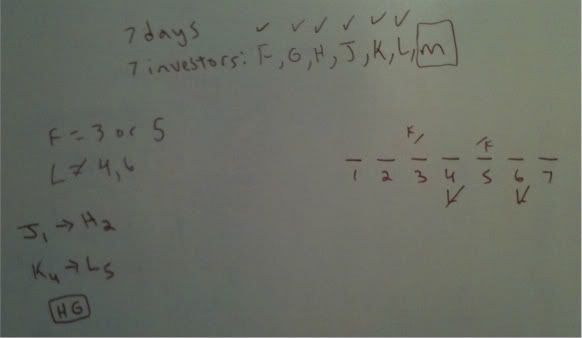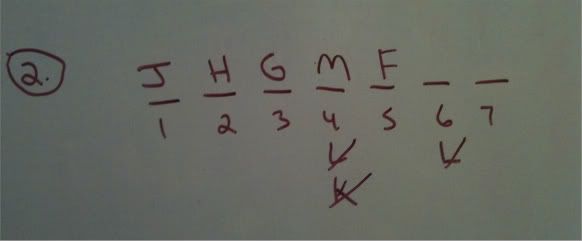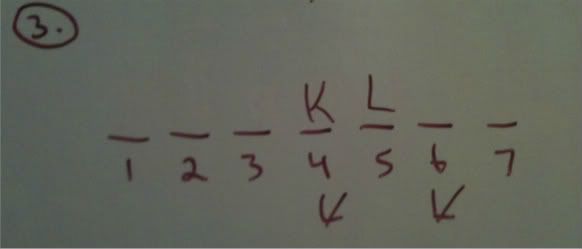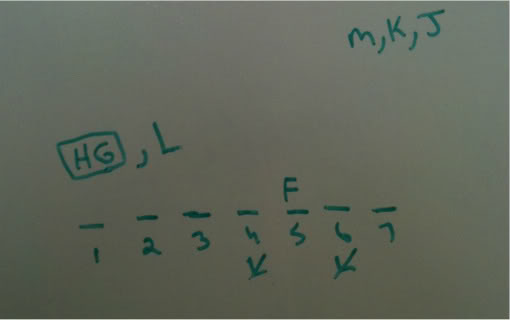LSAT Forum
6 postsPage 1 of 1
-

- mwester002
-
Thanks Received: 0
-
Vinny Gambini

- Posts: 1
- Joined: December 28th, 2010
Diagram
Could I get a diagram for this Logic game?
-

- timmydoeslsat
-
Thanks Received: 887
-
Atticus Finch

- Posts: 1136
- Joined: June 20th, 2011

- Most Thanked

- First Responder
Re: Diagram
This can be used as a global diagram for this game. This game is a one-to-one correspondence in terms of numerical distribution. Each slot will be used by one of the investors and all 7 investors will be used.

The checkmarks above each variable represent that the variable is discussed in at least one of the rules. Notice that I boxed in the letter "M" as it is not discussed. This can be called a floater, free agent or random variable in the game.
There are no significant inferences up front other than seeing the dynamic of the F = 3 or 5 rule and the K(4) ---> L(5) rule.
If K is in 4, then L must be in F. The F variable must go in either 3 of 5, so since 5 is occupied, it must go in 3.
Also notice that if F is in 5 during the game, then we know that K could not be in 4, as via the contrapositive, if L is NOT in 5, which would be the case, then K cannot be in 4.
The J(1) ---> H(2) also plays upon this idea, as we know HG form a block. That would mean that J(1) ---> H(2)G(3), which would force F into spot 5 and would mean, as we discussed earlier, that K cannot be in the 4th spot.
I will go over questions 2 and 3 to show how this game works. Please tell me if anything does not make sense or if there is a question you cannot figure out.
#2.

If J is in the first spot, then we know via the third constraint that H must be in spot 2. Then via the fifth and final rule, that HG form a block. That would then place G on day 3. This would then force F into the 5th spot.

Since F is in the fifth spot, that means, of course, that L cannot be in the fifth spot, which means that K cannot be fourth via the contrapositive.
We now have two "not rules" below the fourth slot. There are only 3 slots left to place, which means three variables left. Since L and K cannot go in the fourth slot, that forces the random variable M into that slot!

Notice that L has "not rules" under the sixth slot and there are only two slots left to fill, 6 and 7. This means that L must go in the 7th slot. Only one spot left to fill with the remaining variable. K into slot 6 it is!

#3

I placed the local condition into the diagram. K goes in day 4, which triggers the rule that L goes into day 5. Remember the F rule! F must go in either 3 or 5. F will be in 3 since L is in 5.

We now need to look at the next part of the local condition given in the third question. This can be denoted simply as J-M. J is before M is what that denotes. The M does not have to be directly after the J.

And notice that J could not go first! This is because if J goes first, then HG fill up the 2,3 slots. 3 is occupied by F! If J cannot go first, and it must be before M, then it must fill up the last two spots as a block itself. This is because there are four variables and two sets of 2 side by side slots. You can essentially see that this is a HG block and a JM block now. The JM block cannot go 1,2...so the HG block must go there with the JM block going 6,7.


The checkmarks above each variable represent that the variable is discussed in at least one of the rules. Notice that I boxed in the letter "M" as it is not discussed. This can be called a floater, free agent or random variable in the game.
There are no significant inferences up front other than seeing the dynamic of the F = 3 or 5 rule and the K(4) ---> L(5) rule.
If K is in 4, then L must be in F. The F variable must go in either 3 of 5, so since 5 is occupied, it must go in 3.
Also notice that if F is in 5 during the game, then we know that K could not be in 4, as via the contrapositive, if L is NOT in 5, which would be the case, then K cannot be in 4.
The J(1) ---> H(2) also plays upon this idea, as we know HG form a block. That would mean that J(1) ---> H(2)G(3), which would force F into spot 5 and would mean, as we discussed earlier, that K cannot be in the 4th spot.
I will go over questions 2 and 3 to show how this game works. Please tell me if anything does not make sense or if there is a question you cannot figure out.
#2.

If J is in the first spot, then we know via the third constraint that H must be in spot 2. Then via the fifth and final rule, that HG form a block. That would then place G on day 3. This would then force F into the 5th spot.

Since F is in the fifth spot, that means, of course, that L cannot be in the fifth spot, which means that K cannot be fourth via the contrapositive.
We now have two "not rules" below the fourth slot. There are only 3 slots left to place, which means three variables left. Since L and K cannot go in the fourth slot, that forces the random variable M into that slot!

Notice that L has "not rules" under the sixth slot and there are only two slots left to fill, 6 and 7. This means that L must go in the 7th slot. Only one spot left to fill with the remaining variable. K into slot 6 it is!

#3

I placed the local condition into the diagram. K goes in day 4, which triggers the rule that L goes into day 5. Remember the F rule! F must go in either 3 or 5. F will be in 3 since L is in 5.

We now need to look at the next part of the local condition given in the third question. This can be denoted simply as J-M. J is before M is what that denotes. The M does not have to be directly after the J.

And notice that J could not go first! This is because if J goes first, then HG fill up the 2,3 slots. 3 is occupied by F! If J cannot go first, and it must be before M, then it must fill up the last two spots as a block itself. This is because there are four variables and two sets of 2 side by side slots. You can essentially see that this is a HG block and a JM block now. The JM block cannot go 1,2...so the HG block must go there with the JM block going 6,7.

-

- panman36
-
Thanks Received: 5
-
Jackie Chiles

- Posts: 28
- Joined: May 13th, 2011
Re: Diagram
On rules like 3 and 4 I started to work out the deductions I could make based on the hypothetical, and write them out.
For example for number 3:
J1 ---> H2 J H G M F K
L
Now I'm wondering if this is worth the extra time up front. I don't see anyone recommending doing this. Any thoughts?
For example for number 3:
J1 ---> H2 J H G M F K
L
Now I'm wondering if this is worth the extra time up front. I don't see anyone recommending doing this. Any thoughts?
-

- timmydoeslsat
-
Thanks Received: 887
-
Atticus Finch

- Posts: 1136
- Joined: June 20th, 2011

- Most Thanked

- First Responder
Re: Diagram
panman36 Wrote:On rules like 3 and 4 I started to work out the deductions I could make based on the hypothetical, and write them out.
For example for number 3:
J1 ---> H2 J H G M F K
L
Now I'm wondering if this is worth the extra time up front. I don't see anyone recommending doing this. Any thoughts?
This is not the type of game where that is really going to benefit you.
This is a more rule driven game, much like sequencing is.
I would say that when you come across this situation, and you are like, "Hey, when J is first, I have the whole sequence completed!" you can simply remember that. However, the test writers aren't probably going to test J going first a whole lot. They want to prey upon uncertain things.
-

- emarxnj
-
Thanks Received: 0
-
Vinny Gambini

- Posts: 6
- Joined: February 18th, 2011
Re: Diagram
Could someone explain the last question of this game? I had no problems with this game's setup and the first six but I just kinda drew a blank at the end. I understand the question places F into the 5th slot, with four spaces open before it, where the HG-block and L need to fit, and that L must be in one of the first three slots, but I just couldn't put it all together.
-

- timmydoeslsat
-
Thanks Received: 887
-
Atticus Finch

- Posts: 1136
- Joined: June 20th, 2011

- Most Thanked

- First Responder
Re: Diagram
emarxnj Wrote:Could someone explain the last question of this game? I had no problems with this game's setup and the first six but I just kinda drew a blank at the end. I understand the question places F into the 5th slot, with four spaces open before it, where the HG-block and L need to fit, and that L must be in one of the first three slots, but I just couldn't put it all together.
Good job on making that deduction. We need to think about the consequences of what you said. That is what logic games is all about!
We know that we have a HG block and a L that must be placed in four spaces. We only have room for one more variable.

We have three variables not talked about yet, M K J.
So one of those will be included in that area before F, and two of those will be included after F.
We know F cannot go in slot 3, so get rid of A.
G is definitely one to try.
You could place G in slot 3, which puts H in slot 2. We know that L cannot go in 4, so it must go in slot 1. So we need one of M K J to go in slot 4. We know that K cannot go in slot 4 because of F being 5, which prohibits K from being in slot 4.
So either of M or J can work in slot 4. Whichever one not chosen for slot 4, will join K after F. Even that order is not restrained by our rules. So we have proven that G can go in slot 3.
After that seeming to be too easy, I decided to test out choice C, which is J, just to make sure I was not missing something.
I noticed that if you were to place J in slot 3, that forces our hand to place the HG block in 1-2, and this would force L into slot 4, which cannot happen.
Notice the rest of the answers, it is the same story. J, K, M would all force HG to go 1-2 and would place L in the fourth slot.
6 posts Page 1 of 1